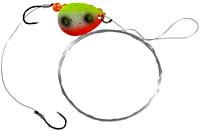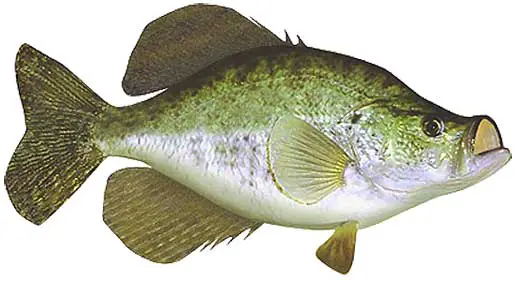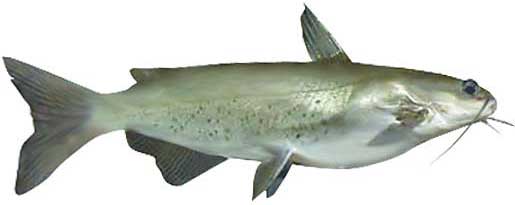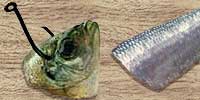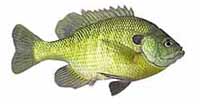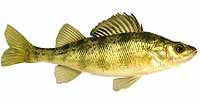Fishing Report For Prairie Creek Reservoir, IN
By Rick Seaman
Last updated on .
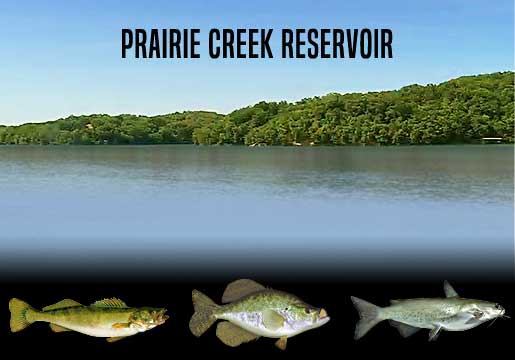
Fishing Reports
Popular Fish Species Prairie Creek Reservoir, IN
Walleye
Current Report: Fair To Good<
FALL. Fall brought cooler temperatures to shallow water, drawing walleye and baitfish shallower. Walleye continue to be a major draw for anglers. Locals report catching nice walleye on long points, flats along the river and creek channels, and structure off shore. Jigs, swimbaits, spoons, crankbaits, jerkbaits, and spinnerbaits are all historically good for catching walleye this time of year. Early Fall finds them in 10 to 20 feet of water. Later in Fall, they move out slightly deeper. Dragging jigs, bottom bouncers, or worm harnesses with nightcrawlers or leeches, around ledge drop-offs is catching walleye fairly consistently. Watch for the bigger walleye to be slightly deeper than the majority of the school.
WINTER. This Winter fishing for walleye has been pretty good through the ice, for the last few years. Before, during and after the ice, anglers report catching them in the main basin area, in 15 to 22 feet of water, along deep creek channel edges, rocky humps and ledges. They can be another 8 to 10 feet deeper on the north section. Steep drops in the area toward the dam are also producing during these cold months. They primarily feed on small fish, staying close to the bottom. After ice-out blade baits, jigs, swimbaits, spoons, deep-diving crankbaits, and worm harness spinners, all work while deep trolling or drifting.
SPRING. Early Spring brings warming water in the shallows, and draws walleye here to feed, especially rocky areas and inlet channels. In Spring, walleye move shallow, often holding in 8 to 12 feet of water. The south end of the lake is a popular area, especially around the old road bed. Work points, drop offs, submerged structure, rock ledges, flats and flats adjacent to deeper water. Here, in 10 to 15 feet deep, they will spawn once the water warms to the mid to high 40's. When they move shallow, bright colored jigs, tipped with minnows or nightcrawlers typically catch them. Spinnerbaits, jerkbaits and crankbaits are also working when walleye are up shallow. Afterwards, they move to 20 to 25 feet deep around points, flats, shoals and ledges, nearby shore, often staying in close proximity to their spawning locations.
SUMMER. Water temperatures rise in Summer, and walleye fishing is good if you can get your bait deep enough. Early in Summer, walleye tend to concentrate in 8 to 20 feet of water. Throughout Summer, early in the morning, and from dusk to long after dark are good times to catch walleye. At those times they move slightly shallower to feed in low-light conditions. Night fishing is often good in Summer, as well. The rest of the time they are cruising flats and creek channel edges, 15 to 20 feet deep , preferring the cooler temperatures. When the bite is slow, grubs and nightcrawlers, fished just off the bottom typically catch walleye.
White Crappie
Current Report: Poor To Fair
FALL. Baitfish, which are moving into shallow flats, coves and bays, are drawing crappie into these areas. Crappie fishing reports have been generally slow lately at Prairie Creek Reservoir. However, if you locate a school, the fishing can be decent. They are feeding heavily in preparation for the cold Winter, in 8 to 18 feet of water. Minnows, hair jigs, and crappie jigs, are good options during this feeding marathon. Late fall starts the migration deeper, toward winter holding areas, for both crappie and baitfish. Small flutter spoons, fished in 15 to 20 feet of water, are a good option during this transition. Good results are coming around points, creek channels, and brush piles.
WINTER. Once the shallows start cooling rapidly, crappie will migrate to deeper holding areas, mostly off shore. At this time they are typically caught using a very slow presentation, in 12 to 22 feet of water. Most are caught around deep brush piles, creek channel bends, submerged timber, and main-lake structure. The south end of the lake, especially around the old road bed, is a good place to find schools. If they are suspending in open water, they often relate to some cover, or structure change, directly below them. During warming trends, especially warm afternoons, they are drawn into 8 to 15 feet of water to feed.
SPRING. In early Spring, crappie begin staging in 5 to 10 feet of water, just outside spawning bays and shallow flats. Spring is the premiere time to be on the water as crappie move into shallow coves to spawn. The two coves behind the two S 560 E Rd Bridges are a good place to find crappie. At that time, they are typically caught in 2 to 8 feet of water. Vegetation, docks, brush and wood are where most anglers catch crappie using small crappie jigs or live minnows. After the spawn, crappie typically move outside the spawning area and hold on cover close by, in 6 to 12 feet of water. Once they move deep, anglers report success using fish finders and forward facing sonar to locate schools of crappie, which tend to stack vertically around cover. Light tackle, with 4 lb to 8 lb line, is a popular choice.
SUMMER. Water temperatures get quite warm, and crappie fishing is usually pretty good. They feed in 5 to 12 feet of water early and late in the day, until the hot Summer sun causes them to retreat to depths of 12 to 15 feet. Also, a few have embedded in the shade of slightly shallower vegetation. This is a good time to focus around brush piles, standing timber, deep lay downs, bridge pilings and deeper docks. Anglers are also locating schools of crappie hanging over deep structure and around creek channel edges, using fish-finder electronics.
Channel Catfish
Current Report: Good
FALL. Fall is one of the better times of year for catching channel catfish. Fishing for channel catfish, day or night, has been quite good this year. Locals report catching nice channel cats on flats all around the throughout the lake. Early in Fall they cruise the 6 to 18 feet deep shallows, in search of food. Later, in the season they migrate away from shallows and any current, to moderately deep flats and channel edges on the main body of the lake. They can typically be found from 10 to 25 feet deep. Fishing for channel catfish is often productive around any kind of structure. Road beds, creek channels and rocky points are all good places to begin. Drift fishing or slow-trolling baits along mid-depth structure is popular and generally productive. Use a slip sinker or Carolina rig setup. Use cut bait, nightcrawlers, shrimp or prepared baits. They remain in these areas and feed aggressively in preparation for Winter.
WINTER. In Winter, the channel cats gather in deep holes and go virtually dormant, especially if water cools into the 40's. They hole up in pockets, deeper channels, ledges, and the basin areas from 20 to 35 feet deep and await warmer water. Slow presentations, especially cut bait, can still entice strikes. Often during mid day, through the afternoon, anglers are catching them a bit shallower on the same structure.
SPRING. In Spring, when water temperatures rise into the high 40's, channel catfish start their migration into coves and up river. Early in the season, look for them in 12 to 24 feet of water. They hold here, and feed aggressively, around relatively shallow cover until water warms into the mid 70's, at which time they begin the spawn process. Anglers are using slip sinkers, 3-way rigs, or Carolina rigs to get, and keep, the bait close to the bottom. Later in Spring, focus on shallower flats into late evening.
SUMMER. In Summer, slow-moving water, at the river end of the lake may draw catfish to feed. Otherwise they are scattering, locating cover in slightly cooler water.The old road bed at the south end of the lake, rip rap by the dam, the marina shoreline and main creek channel breaks, produce good fishing during the warmer months. Reports indicate the most successful anglers are using nightcrawlers, cut bait, minnows or shrimp. Most channel cats hold in 8 to 20 feet during the day, and 5 to 10 feet during the night. Fishing from late in the day until midnight produces some of the best results, as this is their prime feeding time.
Fishing Video
Fish species to fish for...
Guide to fishing for largemouth bass, channel catfish, black crappie, walleye, bluegill, yellow bass and yellow perch at Prairie Creek Reservoir in Indiana.
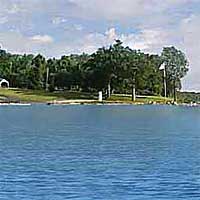 Prairie Creek Reservoir is a 1,200-acre lake with nearly 16 miles of shoreline, and a great mix of fish species. There are fishing options for fishing from the bank or fishing from a boat. Pontoon and deck boats are available for rent at the marina.
Prairie Creek Reservoir is a 1,200-acre lake with nearly 16 miles of shoreline, and a great mix of fish species. There are fishing options for fishing from the bank or fishing from a boat. Pontoon and deck boats are available for rent at the marina.
Primary fish species to catch
Click images for fishing tips and details about each species.
Today's Weather & Forecast
Public Boat Launch Ramps & Landings
Click here for boat ramps.
Fishing License
Click here for a Indiana Fishing License.
Map - Fishing & Access
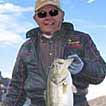 Rick Seaman is a fishing enthusiast with over five decades of fishing experience, a retired tournament fisherman, author of numerous published articles on fishing, and co-author of the book "Bass Fishing - It's not WHAT you throw, It's WHERE you throw it".
Rick Seaman is a fishing enthusiast with over five decades of fishing experience, a retired tournament fisherman, author of numerous published articles on fishing, and co-author of the book "Bass Fishing - It's not WHAT you throw, It's WHERE you throw it".
 Contact Information
Contact Information
Prairie Creek Reservoir
300 North High Street
Muncie, IN 47305
765-747-4776
Fishing lakes in each state
110425
Prairie Creek Reservoir, IN Report
INDIANA


Bass, crappie, walleye and perch fishing in eastern IN.






